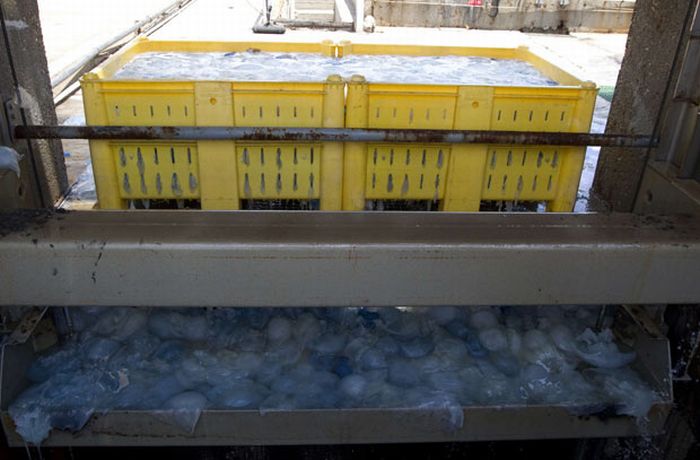|
|
Jellyfish Clog Water Supply, Coal-fired Power Station Orot Rabin, Hadera, Israel
|
After a growth interval, the polyp begins reproducing asexually by budding and, in the Scyphozoa, is called a segmenting polyp, or a scyphistoma. New scyphistomae may be produced by budding or new, immature jellies called ephyrae may be formed. A few jellyfish species can produce new medusae by budding directly from the medusan stage. Budding sites vary by species; from the tentacle bulbs, the manubrium (above the mouth), or the gonads of hydromedusae. A few of species of hydromedusae reproduce by fission (splitting in half).
In the second stage, the tiny polyps asexually produce jellyfish, each of which is also known as a medusa. Tiny jellyfish (usually only a millimeter or two across) swim away from the polyp and then grow and feed in the plankton. Medusae have a radially symmetric, umbrella-shaped body called a bell, which is usually supplied with marginal tentacles - fringe-like protrusions from the bell's border that capture prey. A few species of jellyfish do not have the polyp portion of the life cycle, but go from jellyfish to the next generation of jellyfish through direct development of fertilized eggs.
Other species of jellyfish are among the most common and important jellyfish predators, some of which specialize in jellies. Other predators include tuna, shark, swordfish, sea turtles and at least one species of Pacific salmon. Sea birds sometimes pick symbiotic crustaceans from the jellyfish bells near the sea's surface, inevitably feeding also on the jellyfish hosts of these amphipods or young crabs and shrimp.
Jellyfish lifespans typically range from a few hours (in the case of some very small hydromedusae) to several months. Life span and maximum size varies by species. One unusual species is reported to live as long as 30 years. Another species, Turritopsis dohrnii as T. nutricula, may be effectively immortal because of its ability to transform between medusa and polyp, thereby escaping death. Most large coastal jellyfish live 2 to 6 months, during which they grow from a millimeter or two to many centimeters in diameter. They feed continuously and grow to adult size fairly rapidly. After reaching adult size, jellyfish spawn daily if there is enough food. In most species, spawning is controlled by light, so the entire population spawns at about the same time of day, often at either dusk or dawn.
|
|









